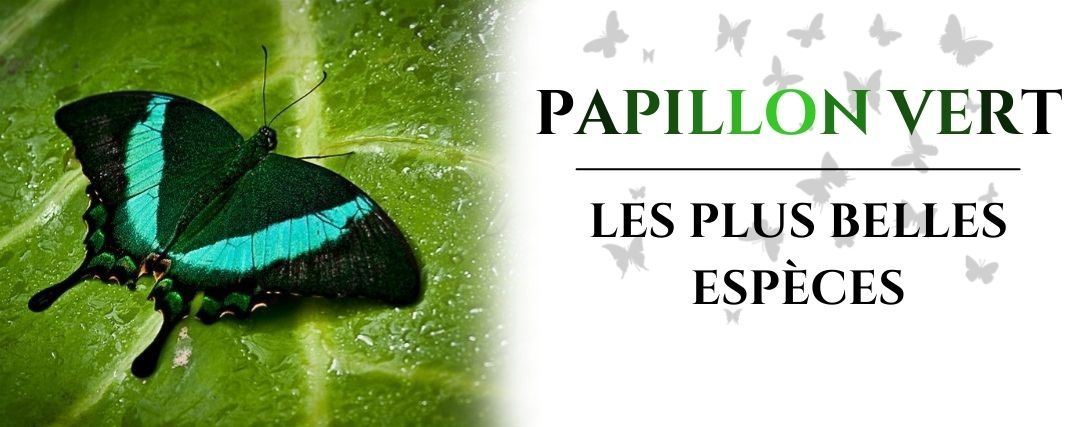Associated with nature, fertility and more generally life, green is a reassuring and soothing color. Being able to contemplate butterflies in shades of green is a real visual pleasure.
In this article, you will see what symbolism is associated with lepidoptera with green wings, as well as some magnificent species of green butterflies selected by us.
What do green butterflies symbolize?
A green butterfly is especially associated with progress, luck and abundance. But that's not all ! Let's learn more about the symbolism and meaning of the green butterfly!
Encountering a green butterfly can symbolize growth and flourishing development, whether in a relationship, business, or personal hobby. It represents prosperity and good results.
A green colored butterfly can also represent luck and money.
If a green butterfly flies towards you or circles around you, it can mean that something positive will soon come into your life, or that you will have a pleasant encounter.
When we see a green butterfly, it often brings a message of hope and encouragement. It brings with it a feeling of joy and calm, especially if it lands on you.
Strangely, in voodoo, the green butterfly is linked to the spirit of Bakulu-Baka. Bakulu-Baka both binds and frees the captives. He is considered a violent spirit who shakes chains. This may mean you have his protection or an omen of things to follow.
In Chinese mythology, a green butterfly is a symbol of good. It also represents love.
The most beautiful species of green butterflies around the world
Philaethria dido

Philaethria dido, is a butterfly belonging to the Nymphalidae family. It is found in Central America and tropical South America, east and west of the Andes, from Brazil and Ecuador north to Mexico. Individuals can sometimes be found wandering in the lower Rio Grande Valley of southern Texas.
This butterfly has a wingspan of approximately 110 mm, and in Mexico it is in flight from July to December. The upper surface of the wings is black, with translucent green spots. The underside is similar with some brown streaks with gray scales.
Philaethria dido is often confused with Siproeta stelenes which we present to you a little further down. They have similar coloration, but the shape of their wings is different and while P. dido flies high in the canopy, S. stelenes is often seen in clearings and open secondary forests.
The flight of this butterfly is fast and direct and it flies mainly through the canopy and along waterways, but can also be seen in clearings. It occurs in tropical rainforests at altitudes from zero to 1200 meters but is absent from deciduous forests.
Philaethria dido feeds on the nectar it obtains from the flowers of forest trees like Cissus. Males normally fly high in the canopy but sometimes descend to sunny stream banks or gravel beaches along rivers to sip mineral-rich water.
Papilio palinurus

Papilio palinurus, also called the emerald swallowtail, is a butterfly of the Papilionidae family. It is native to Southeast Asia, but is regularly kept in butterfly houses around the world.
The wing span of Papilio palinurus reaches approximately 8-10 centimeters. Its wings are sprinkled with a powder of green scales on a background that varies from dark greenish to black, with large and beautiful shiny emerald green metallic bands. The underwings are black with orange, white, and blue spots along the hindwing edges, which show extended tails at the tips.
The iridescent green sheen of this sublime butterfly's bands is not produced by pigments, but is a structural coloration that is produced by the microstructure of the wing scales. These refract light and give rise to visible blue and yellow reflections, producing the perception of the color green when mixed additively.
The flight of these butterflies is lively and quite rapid. The caterpillars feed on plants of the Euodia genus belonging to the Rutaceae, commonly known as the rue or citrus family.
This species is mainly found in Southeast Asia. It lives in primary Asian forests.
Graphium Agamemnon

Graphium agamemnon, also called the green sailfish, is a tropical butterfly belonging to the Papilionidae family.
The wings of this butterfly have a dominant black color colored by green spots arranged in a remarkable way. We let you admire the photo below which speaks for itself! It has a wingspan of 80 to 90 mm.
It is a common, non-threatened species native to Nepal, India, Sri Lanka, Southeast Asia and Australia.
Once found mainly near wooded countryside where rainfall is quite plentiful, Graphium agamemnon is now very common at lower altitudes and regularly seen in gardens and urban areas due to its food plant, Polyalthia longifolia, which is widely used as a ornamental tree.
Siproeta stelenes

The Siproeta stelenes, also called malachite, is a neotropical butterfly of the Nymphalidae family.
Malachite has large wings that are black and shiny green or yellow-green on top and light brown and olive green on the underside. It owes its name to the mineral malachite, whose color is similar to the brilliant green of this butterfly's wings. The wing span is generally between 8.5 and 10 cm.
They are often confused with Philaethria dido which we presented to you above. They have similar coloring, but the shape of their wings is different.
Siproeta stelenes occurs throughout Central America and northern South America, where it is one of the most common butterfly species. Its distribution extends north to southern Texas and the tip of Florida to Cuba.
Adults feed on nectar from flowers, rotting fruit, dead animals and bat droppings. Females lay their eggs on the new leaves of plants in the Acanthaceae family, particularly ruellia. The larvae are black caterpillars with horns, spiny and marked with red. The chrysalis stage is green and has sharp, golden spines that can pierce predators.
Teinopalpus imperialis

Teinopalpus imperialis, also named the Kaiser-i-Hind, is a butterfly belonging to the Papilionidae family. Its common name literally means "emperor of India".
The Kaiser-i-Hind, like the Glory of Bhutan , is unique and cannot be confused with any other butterfly. It is a predominantly green butterfly, the male of which has a bright chrome yellow spot on each hind wing. It has a wingspan ranging from 90 to 127 mm.
It is found from Nepal and northern India to northern Vietnam. The Kaiser-i-Hind is highly sought after by butterfly collectors for its beauty and rarity. The green iridescence of the wings is due to a three-dimensional photonic structure of the scales and is the subject of much research.
Teinopalpus imperialis is a species of high altitude forest butterfly. It is found at medium to high altitudes in the Himalayas ranging from 1,800 to 3,000 meters, in forested terrains.
Daphnis nerii

Daphnis nerii, also called the Oleander Hawkmoth, is a moth of the family Sphingidae.
Its green body and wings are decorated with sinuous lines of a darker green and a more or less marked salmon pink. It has an average wingspan ranging from 80 to 120 mm.
Daphnis nerii is a large moth found in large areas of Africa, Asia and some Hawaiian Islands where it has been introduced to control introduced and invasive oleanders as well as to pollinate species threatened Brighamia insignis and Brighamia rockii which previously had to be hand pollinated. It is a migratory species, flying to parts of Eastern and Southern Europe during the summer, particularly Turkey.
Adults feed on nectar from a wide variety of flowers. They have a preference for fragrant species such as petunia, jasmine and honeysuckle. They are particularly active at dusk, and can be seen hovering over flowers after sunset.
The caterpillars feed primarily on the leaves of oleander (Nerium oleander), a highly toxic plant, to which the caterpillars are immune.
Actias luna
Actias luna, also known as the moon moth, is a Nearctic moth in the family Saturniidae. It has lime green wings and a white body. The caterpillars are also green. Typically, the wing span is about 114 mm, but it can exceed 178 mm, making it one of the largest moths in North America.
Females and males are similar in size and appearance: green wings, eyespots on the fore and hind wings, and long tails, sometimes a little twisted, extending from the posterior edge of the hind wings. The body is white and hairy. Adults have vestigial mouthparts and do not feed. They get their energy from fat reserves created when they were caterpillars. The anterior edge of the forewing is dark colored and thick, decreasing in thickness from the thorax to the wing tip. Its color can range from brown to brown. The ocelli, one per wing, are oval in shape on the forewings and round on the hindwings. Each eyespot can have arcs of black, blue, red, yellow, green or white.
In Canada, it has one generation per year, the winged adults appearing at the end of May or the beginning of June, while further south, it will have two or even three generations per year, the first appearance being made as early as March in southern regions of the United States.





